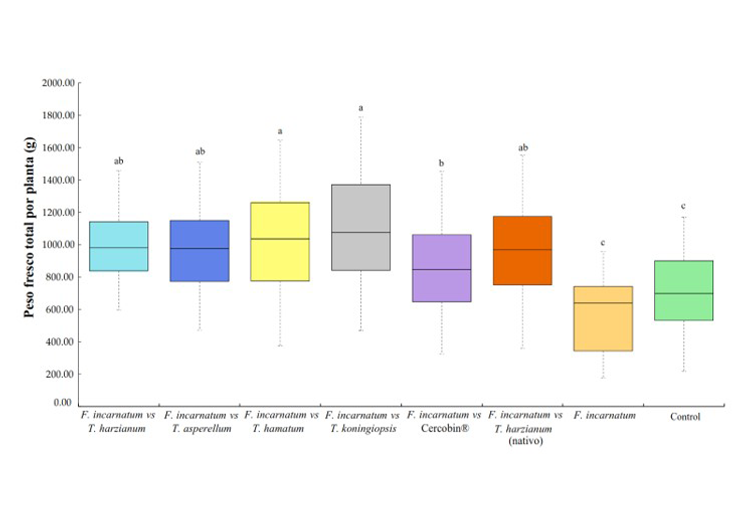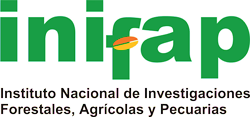Biological control of vascular wilt by Trichoderma spp. for peanut crops
DOI:
https://doi.org/10.29312/remexca.v16i5.3787Keywords:
Trichoderma spp, antifungal activity, basal necrosisAbstract
In Mexico, peanut crops are a productive activity in rural areas; nevertheless, they are threatened by fungal diseases, such as vascular wilt, caused by Fusarium incarnatum, recently reported in the country. The study assessed the antagonistic capacity of five Trichoderma species against the ‘MA-PET-03’ strain of F. incarnatum in peanut crops in Buenavista de Benito Juárez, Chietla, Puebla. It was highlighted that T. koningiopsis showed the highest growth rate and the highest percentage of radial growth inhibition (PRGI) of F. incarnatum in in vitro tests. Under field conditions, treatments with Trichoderma spp. had more peanut pods per plant and lower incidence of the disease, improving crop yield. These results confirm the effectiveness of Trichoderma spp. for managing vascular wilt in the region.
Downloads
References
Abdullah, N. S.; Doni, F.; Mispan, M. S.; Saiman, M. Z.; Yusuf, Y. M.; Oke, M. A. and Suhaimi, N. S. M. 2021. Harnessing Trichoderma in agriculture for productivity and sustainability. Agronomy. 11(12):2559-2576. https://doi.org/10.3390/agronomy11122559.
Akram, N. A.; Shafiq, F. and Ashraf, M. 2018. Peanut (Arachis hypogaea L.): a prospective legume crop to offer multiple health benefits under changing climate. Compr. Rev. Food Sci. Food Saf. 17(5):1325-1338. https://doi.org/10.1111/1541-4337.12383.
Andrade-Hoyos, P.; Luna-Cruz, L.; Osorio-Hernández, E.; Molina-Gayosso, E.; Landero-Valenzuela, N. y Barrales-Cureño, H. J. 2019. Antagonismo de Trichoderma spp. vs. hongos asociados a la marchitez de chile. Revista Mexicana de Ciencias Agrícolas. 10(6):1259-1272. https://doi.org/10.29312/remexca.v10i6.1326.
Andrade-Hoyos, P.; Rivera-Jiménez, M. N.; Landero-Valenzuela, N.; Silva-Rojas, H. V.; Martínez-Salgado, S. J. y Romero-Arenas, O. 2023. Beneficios ecológicos y biológicos del hongo cosmopolita Trichoderma spp. en la agricultura: una perspectiva en el campo mexicano. Revista Argentina de Microbiología. 55(4):366-377. https://doi.org/10.1016/j.ram.2023.06.005.
Asad, S. A. 2022. Mechanisms of action and biocontrol potential of Trichoderma against fungal plant diseases a review. Ecol. Complex. 49(1)e100978. https://doi.org/10.1016/j.ecocom.2021.100978.
Bell, D. K.; Pozos, H. D. and Markham, C. R. 1982. In vitro antagonism of Trichoderma species against six fungal plant pathogens. Phytopathology. 72(4):379-382. https://doi.org/10.1094/PHYTO-72-379.
Blanco, M. M.; Castro, Z. O. y Umaña, R. G. 2022. Estudio preliminar de especies de Fusarium presentes en piña (Ananas comosus) en Costa Rica. Agron. Costarricense. 46(1):47-64. https://doi.org/10.15517/rac.v46i1.49867.
Bokade, P.; Purohit, H. J. and Bajaj, A. 2021. Myco-remediation of chlorinated pesticides: insights into fungal metabolic system. Indian J. Microbiol. 61(3):237-249. https://doi.org/10.1007/s12088-021-00940-8.
Bokhari, N. A. and Perveen, K. 2012. Antagonistic action of Trichoderma harzianum and Trichoderma viride against Fusarium solani that causes tomato root rot. África. J. Microbiol. Res. 6(44):7193-7197. https://doi.org/10.5897/AJMR12.956.
Desmae, H.; Janila, P.; Okori, P.; Pandey, M. K; Motagi, B. N.; Monyo, E.; Mponda, O.; Okello, D.; Sako, D.; Echeckwu, C.; Oteng-Frimpong, R.; Miningou, A.; Ojiewo, C. and Varshney, R. K. 2018. Genetics, genomics and breeding of ground nuts (Arachis hypogea L.). Plant Breed. 138(4):425-444. https://doi.org/10.1111/pbr.12645.
Diabankana, R. G. C.; Frolov, M.; Islamov, B.; Shulga, E.; Filimonova, M. N.; Afordoanyi, D. M. and Validov, S. 2024. Identification and aggressiveness of Fusarium species associated with onion bulb (Allium cepa L.) during storage. J. Fungi. 10(2):161-179. https://doi.org/10.3390/jof10020161.
Dubey, S. C.; Tripathi, A.; Dureja, P. and Grover, A. 2011. Characterization of secondary metabolites and enzymes produced by Trichoderma species and their efficacy against plant pathogenic fungi. Indian J. Agric. Sci. 81(5):455-461.
FAO. 2023. Food and Agriculture Organization of the United Nations. Available online. https://www.fao.org/faostat/en/#data/QCL.
Husseina, N. A.; Al-Janabib, H. J.; Al-Mashhadyc, F. R.; Al-Janabia, J. K. A. and Al-Shujairia, A. R. S. 2022. Antagonistic activities of bioagent fungi Trichoderma harzianum and Pleurotus ostreatus against three species of Fusarium in cucumber plants. Asia Pac. J. Mol. Biol. Biotechnol. 30(1):12-21. https://doi.org/10.35118/apjmbb.030.1.02.
Illa, C.; Andres-Perez, A.; Matias, T. y Perez, M. A. 2019. Efecto de biocontrol y promoción del crecimiento en maní por Trichoderma harzianum y Bacillus subtilis en condiciones controladas y de campo. Revista Mexicana de Fitopatología. 38(1):119-131. https://doi.org/10.18781/r.mex.fit.1910-6.
Intana, W.; Kheawleng, S. and Sunpapao, A. 2021. Trichoderma asperellum T76-14 released volatile organic compounds against postharvest fruit rot in muskmelons (Cucumis melo) caused by Fusarium incarnatum. J. Fungi. 7(1):e46. https://doi.org/10.3390/jof7010046.
Kong, W. L.; Ni, H.; Wang, W. Y. and Wu, X. Q. 2022. Antifungal effects of volatile organic compounds produced by Trichoderma koningiopsis T2 against Verticillium dahliae. Front. Microbiol. 21(13):e1013468. https://doi.org/10.3389/fmicb.2022.1013468.
Mannai, S.; Jabnoun-Khiareddine, H.; Nasraoui, B. and Daami-Remadi, M. 2018. Rhizoctonia root rot of pepper (Capsicum annum): comparative pathogenicity of causal agent and biocontrol attempt using fungal and bacterial agents. J. Plant Pathol. Microbiol. 9(2):431-439. https://doi.org/10.4172/2157-7471.1000431.
Montero-Torres, J. 2020. Importancia nutricional y económica del Cacahuate (Arachis hypogaea L.). Revista de Investigación e Innovación Agropecuaria y de Recursos Naturales. 7(2):112-125.
Nawrocka, J.; Gromek, A. and Małolepsza, U. 2019. Nitric oxide as a beneficial signaling molecule in Trichoderma atroviride TRS25-induced systemic defense responses of cucumber plants against Rhizoctonia solani. Front. Plant Sci. 10(10):421-436. https://doi.org/10.3389/fpls.2019.00421.
Romero-Arenas, O.; Andrade-Hoyos, P.; Silva-Rojas, H. V.; Luna-Cruz, A. and Martínez-Salgado, S. J. 2024. First report vascular wilt on peanut in Mexico caused by Fusarium incarnatum. Plant Dis. 108(1):e208. https://doi.org/10.1094/PDIS-05-23-0877-PDN.
SIAP. 2024. Servicio de Información Agroalimentaria y Pesquera. https://www.gob.mx/siap.
Stehlik-B. K. and Babinec, A. J. 2017. Data analysis with IBM SPSS statistics. Packt Publishing Ltd. 446 p.
Thirumalaisamy, P. P.; Dutta, R.; Jadon, K. S.; Nataraja, M. V.; Padvi, R. D.; Rajyaguru, R. and Yusufzai, S. 2019. Association and characterization of the Fusarium incarnatum-F. equiseti species complex with leaf blight and wilt of peanut in India. J. Gen. Plant Pathol. 85(2):83-89. https://doi.org/10.1007/s10327-018-0827-y.
Tralamazza, S. M.; Piacentini, K. C.; Savi, G. D.; Carnielli, Q. L.; De Carvalho-Fontes, L.; Martins, C. S.; Corrêa, B. and Rocha, L. O. 2021. Wild rice (O. latifolia) from natural ecosystems in the Pantanal region of Brazil: host to Fusarium incarnatum-equiseti species complex and highly contaminated by zearalenone. Int. J. Food Microbiol. 345(4):109-127. https://doi.org/10.1016/j.ijfoodmicro.2021.109127.
Wang, M. M.; Chen, Q.; Diao, Y. Z.; Duan, W. J. and Cai, L. 2019. Fusarium incarnatum-equiseti complex from China. Persoonia. 43(3):70-89. https://doi.org/10.3767/persoonia.2019.43.03.
Wonglom, P. and Sunpapao, A. 2020. Fusarium incarnatum is associated with postharvest fruit rot of muskmelon (Cucumis melo). J. Phytopathol. 168(1):204-210. https://doi.org/10.1111/jph.12882.
Zamurrad, M.; Tariq, M.; Shah, F. H.; Subhani, A.; Ijaz, M.; Iqbal, M. S. and Koukab, M. 2013. Performance based evaluation of groundnut genotypes under Chakwal medium rainfall conditions. J. Agricole. 1(1):9-12.

Published
How to Cite
Issue
Section
License
Copyright (c) 2025 Revista Mexicana de Ciencias Agrícolas

This work is licensed under a Creative Commons Attribution-NonCommercial 4.0 International License.
The authors who publish in Revista Mexicana de Ciencias Agrícolas accept the following conditions:
In accordance with copyright laws, Revista Mexicana de Ciencias Agrícolas recognizes and respects the authors’ moral right and ownership of property rights which will be transferred to the journal for dissemination in open access. Invariably, all the authors have to sign a letter of transfer of property rights and of originality of the article to Instituto Nacional de Investigaciones Forestales, Agrícolas y Pecuarias (INIFAP) [National Institute of Forestry, Agricultural and Livestock Research]. The author(s) must pay a fee for the reception of articles before proceeding to editorial review.
All the texts published by Revista Mexicana de Ciencias Agrícolas —with no exception— are distributed under a Creative Commons License Attribution-NonCommercial 4.0 International (CC BY-NC 4.0), which allows third parties to use the publication as long as the work’s authorship and its first publication in this journal are mentioned.
The author(s) can enter into independent and additional contractual agreements for the nonexclusive distribution of the version of the article published in Revista Mexicana de Ciencias Agrícolas (for example include it into an institutional repository or publish it in a book) as long as it is clearly and explicitly indicated that the work was published for the first time in Revista Mexicana de Ciencias Agrícolas.
For all the above, the authors shall send the Letter-transfer of Property Rights for the first publication duly filled in and signed by the author(s). This form must be sent as a PDF file to: revista_atm@yahoo.com.mx; cienciasagricola@inifap.gob.mx; remexca2017@gmail.
This work is licensed under a Creative Commons Attribution-Noncommercial 4.0 International license.


